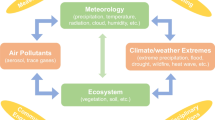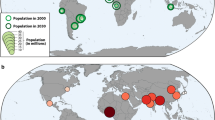Abstract
An uni-modal Lagrangian Dust Model (LDM) was developed to simulate the dust concentrations and source-receptor (SR) relationships for recent Asian dust events that occurred over the Korean Peninsula. The following dust sources were used for the S-R calculation in this study: S-I) Gurbantunggut desert, S-II) Taklamakan desert, S-III) Tibetan Plateau, S-IV) Mu Us Desert, S-V) Manchuria, and S-VI) Nei Mongol and Gobi Desert. The following two 8-day dust simulation periods were selected for two case studies: (Period A) March 15–22, 2011, and (Period B) April 27–May 4, 2011. During two periods there were highly dense dust onsets observed over a wide area in Korea. Meteorological fields were generated using the WRF (Weather Research and Forecasting) meteorological model, and Lagrangian turbulent properties and dust emission were estimated using FLEXPART model and ADAM2 (Asian Dust Aerosol Model 2), respectively. The simulated dust concentrations are compared with point measurements and Eulerian model outputs. Statistical techniques were also employed to determine the accuracy and uncertainty associated with the model results. The results showed that the LDM compared favorably well with observations for some sites; however, for most sites the model overestimated the observations. Analysis of S-R relationships showed that 38–50% of dust particles originated from Nei Mongol and the Gobi Desert, and 16–25% of dust particles originated from Manchuria, accounting for most of the dust particles in Korea. Because there is no nudging or other artificial forcing included in the LDM, higher error indicators (e.g., root mean square error, absolute gross error) were found for some sites. However, the LDM was able to satisfactorily simulate the maximum timing and starting time of dust events for most sites. Compared with the Eulerian model, ADAM2, the results of LDM found pattern correlations (PCs) equal to 0.78-0.83 and indices of agreement (IOAs) greater than 0.6, suggesting that LDM is capable of estimation of dust concentrations with the quantitative information on the S-R relationships that can be easily obtained by LDM.
Similar content being viewed by others
References
Asman, W. A. H., 1995: Parameterization of below-cloud scavenging of highly soluble gases under convective conditions. Atmos. Environ., 29, 1359–1368.
Batsukh, S., 2004: Geographic Atlas of Mongolia. Administration of Land Affairs. Geodesy and Cartography, Ulaanbaatar, 62 pp.
Belly, P.Y., 1964: Sand movement by wind, U.S. Army Coastal Eng. Res. Tech. Memo.
Buritt, B., and A. D. Hyers, 1981: Evaluation of Arizona’s highway dust warning system. Geolog. Soc. of America Bulletin Special Paper, 186, 282–292.
Chock, D. P., and S. L. Winkler, 1994: A particle grid air quality modeling approach 1. The dispersion aspect. J. Geophys. Res., 99, 1019–1031.
Collins, J., D. S. Stevenson, C. E. Johnson, and R. G. Derwent, 1997: Tropospheric ozone in a global-scale three-dimensional Lagrangian model and its response to NOx emission controls. J. Atmos. Chem., 26, 223–274.
Dabdub, D., and J. H. Seinfeld, 1994: Numerical advective schemes used in air quality models sequential and parallel implementation. Atmos. Environ., 28, 3369–3385.
Gillette, D. A., J. Adams, A. Endo, and D. Smith, 1980: Threshold velocities for input of soil particles in the air by desert soils. J. Geophys. Res., 85, 5621–5630.
_____, ______, D. Muhs, and R. Kihl, 1982: Threshold velocities and rupture moduli for crusted desert soils for the input of soil particles into the air. J. Geophys. Res., 87, 9003–9015.
Gong, S. L., X. Y. Zhang, T. L. Zhao, I. G. McKendry, D. A. Jaffe, and N. M. Lu, 2003: Characterization of soil dust aerosol in China and its transport and distribution during 2001 ACE-Asia: 2. Model simulation and validation. J. Geophys. Res., 108(D9), 4262, doi:10.1029/2002-JD002633.
Goudie, A. S., 1977: Sodium sulphate weathering and the disintegration of Mohenjo Daro, Pakistan. Earth Surface Process 2, 75–86.
Greeley, R., and Iversen, J. D., 1985: Wind as a Geological Process on Earth, Mars, Venus and Titan. Cambridge University Press, New York.
Hagen, L., and N. O. Woodruff, 1973: Air pollution in the Great Plains. Atmos. Environ., 7, 323–332.
Hanna, S. R., 1982: Applications in air pollution modeling. In: Nieuwstadt F.T.M. and H. van Dop (ed.): Atmospheric Turbulence and Air Pollution Modelling. D. Reidel Publishing Company, Dordrecht, Holland, 1982.
Harrison, S. P., K. E. Kohfeld, C. Roelandt, and T. Claquin, 2011: The role of dust in climate changes today, at the last glacial maximum and in the future. Earth-Science Reviews, 54(1–3), 43–80.
Haywood, J., and O. Boucher, 2000: Estimates of the direct and indirect radiative forcing due to tropospheric aerosols: A review. Rev. Geophys., 38, 513–543.
Helgren, D. A., and J. M. Prospero, 1987: Wind velocities associated with dust deflation events in the western Sahara. J. Climate Appl. Meteor., 26, 1147–1151.
Hertel, O., J. Christensen, E. H. Runge, W. A. H. Asman, R. Berkowicz, M. F. Hovmand, and O. Hov, 1995: Development and testing of a new variable scale air pollution model — ACDEP. Atmos. Environ., 29, 1267–1290.
Hurley P. J, L. P. William, and K. L. Ashok, 2002: The Air Pollution Model (TAPM) version 2: summary of some verification studies. CSIRO, Clayton.
In, H.-J., and S.-U. Park, 2002: A simulation of long-range transport of Yellow Sand observed in April 1998 in Korea. Atmos. Environ., 36, 4173–4187.
_____, and ______, 2003: A simulation of long-range transport of yellow sand observed in April 1998 in Korea. Atmos. Environ., 36, 4625–4636.
Iversen, J. D., and B. R. White, 1982: Saltation threshold on Earth, Mars and Venus. Sedimentology, 29, 111–119.
Kalma, J. D., J. G. Speight, and R. J. Ludwig, 1988: Potential wind erosion in Australia: A continental perspective. J. Climatol., 8, 411–428.
Klemp, J. B., W. C. Skamarock, and J. Dudhia, 2000: Conservative splitexplicit time integration methods for the compressible nonhydrostatic equations. [Available online at http://wrf-model.org/WG1/wg1pmain.html].
Klung W, G. Graziani, G. Grippa, D. Pierce, and C. Tassone, 1992: The ATMES report. Elsevier, London.
Kurosaki, Y., and M. Mikami, 2003: Recent frequent dust events and their relation to surface wind in East Asia. Geophys. Res. Lett., 30, 1736.
_____, and ______, 2005: Regional difference in the characteristic of dust event in East Asia: Relationship among dust outbreak, surface wind, and land surface condition. J. Meteor. Soc. Japan, 83A, 1–18.
_____, and ______, 2007: Threshold wind speed for dust emission in east Asia and its seasonal variations. J. Geophys. Res., 112, D17202.
Legg, B. J., and M. R. Raupach, 1982: Markov-chain simulation of particle dispersion in inhomogeneous flows: the mean drift velocity induced by a gradient in Eulerian velocity variance. Bound. -Layer Meteor., 24, 3–13.
Legras, B., B. Joseph, and F. Lefevre, 2003: Vertical diffusivity in the lower stratosphere from Lagrangian back-trajectory reconstructions of ozone profiles. J. Geophys. Res., 108, 4562, doi:10.1029/2002JD003045.
Lim, J.Y., and Y. S. Chun, 2006: The characteristics of Asian dust events in Northeast Asia during the springtime from 1993 to 2004. Global Planet. Change, 52, 231–247.
Liu, M., D. L. Westphal, S. Wang, A. Shimizu, N. Sugimoto, J. Zhou, and Y. Chen, 2003: A high-resolution numerical study of the Asian dust storms of April 2001. J. Geophys. Res., 108(D23), 8653, doi:10.1029/2002JD003178.
McMahon, T. A., and P. J. Denison, 1979: Empirical atmospheric deposition parameters — a survey. Atmos. Environ., 13, 571–585.
Park, S.-U., and H.-J. In, 2003: Parameterization of dust emission for the simulation of the yellow sand (Asian dust) event observed in March 2002 in Korea. J. Geophys. Res., 108, 4618.
_____, and E.-H. Lee, 2004: Parameterization of Asian dust (Hwangsa) particle-size distributions for use in dust emission models. Atmos. Environ., 38, 2155–2162.
Peters, L. K., and Coauthors, 1995: The current state and future direction of Eulerian models in simulating the tropospheric chemistry and transport of trace species-a review. Atmos. Environ., 29, 189–222.
Russell, A., and R. Dennis, 2000: NARSTO critical review of photochemical models and modeling. Atmos. Environ., 34, 2283–2324.
Ryall, D. B. and R. H. Maryon, 1997: Validation of the UK Met Office’s NAME model against the ETEX dataset. In: Nodop, K. (editor): ETEX Symposium on Long-Range Atmospheric Transport, Model Verification and Emergency Response, European Commission EUR 17346, 151–154.
Shao, Y., and Coauthors, 2003: Northeast Asian dust storms: Real-time numerical prediction and validation. J. Geophys. Res., 108, 1–18.
Slinn, W. G. N., 1982: Predictions for particle deposition to vegetative canopies. Atmos. Environ., 16, 1785–1794.
Stohl, A., 1998: Computation, accuracy and applications of trajectory — a review and bibliography. Atmos. Environ., 32, 947–966.
_____, C. Forster, A. Frank, P. Seibert, and G. Wotawa, 2005: Technical note: The Lagrangian particle dispersion model FLEXPART version 6.2., Atmos. Chem. Phys., 5, 2461–2474.
Tegen, I., and I. Fung, 1994: Modeling of mineral dust in the atmosphere: Sources, transport, and optical thickness. J. Geophys. Res., 99, 22897–22914.
Thomson D. J., 1987: Criteria for the selection of stochastic models of particle trajectories in turbulent flows. J. Fluid Mech., 180, 529–556.
Uno, I., H. Amano, S. Emori, K. Kinoshita, I. Matsui, and N. Sugimoto, 2001: Trans-Pacific yellow sand transport observed in April 1998: A numerical simulation. J. Geophys. Res., 106, 18,331–18,344.
_____, and Coauthors, 2003: Regional chemical weather forecasting system CFORS: model descriptions and analysis of surface observations at Japanese island stations during the ACE-Asia experiment. J. Geophys. Res., 108, 8668.
Walmsley, J. L, and M. L. Wesely, 1996: Modification of coded parameterizations of surface resistances to gaseous dry deposition. Atmos. Environ., 30, 1181–1188.
Wang, Z., H. Ueda, and M. Huang, 2000: A deflation module for use in modeling long-range transport of yellow sand over East Asia. J. Geophys. Res., 105, 26,947–26,960.
Wang, X., Y. Yang, Z. Dong, and C. Zhang, 2009: Responses of dune activity and desertification in China to global warming in the twenty-first century. Global Planet. Change, 67, 167–185.
Wesely, M. L., and B. B. Hicks, 1977: Some factors that affect the deposition rates of sulfur dioxide and similar gases on vegetation. J. Air Pollut. Control Assoc., 27, 1110–1116.
_____, 1989: Parameterization of surface resistances to gaseous dry deposition in regional-scale numerical models. Atmos. Environ., 23, 1293–1304.
Westphal, D. L., O. B. Toon, and T. N. Carlson, 1988: A case study of mobilization and transport of Saharan dust. J. Atmos. Sci., 45, 2145–2175.
Willmott, C. J., 1981: On the validation of models. Phys Geogr., 2, 184–194.
Xu, Z, Y. Li, Y. Tang, and G. Han, 2009: Chemical and strontium isotope characterization of rainwater at an urban site in Loess Plateau, Northwest China. Atmos. Res., 94, 481–490.
Yang, S., and Z. Ding, 2008: Advance-retreat history of the East-Asian summer monsoon rainfall belt over northern China during the last two glacial-interglacial cycles. Earth Planet. Sci. Lett., 274, 499–510.
Author information
Authors and Affiliations
Corresponding author
Rights and permissions
About this article
Cite this article
Kim, CH., Lee, HJ. Numerical simulations of Asian dust events: A Lagrangian Dust Model and its applications. Asia-Pacific J Atmos Sci 49, 571–586 (2013). https://doi.org/10.1007/s13143-013-0051-9
Received:
Revised:
Accepted:
Published:
Issue Date:
DOI: https://doi.org/10.1007/s13143-013-0051-9




